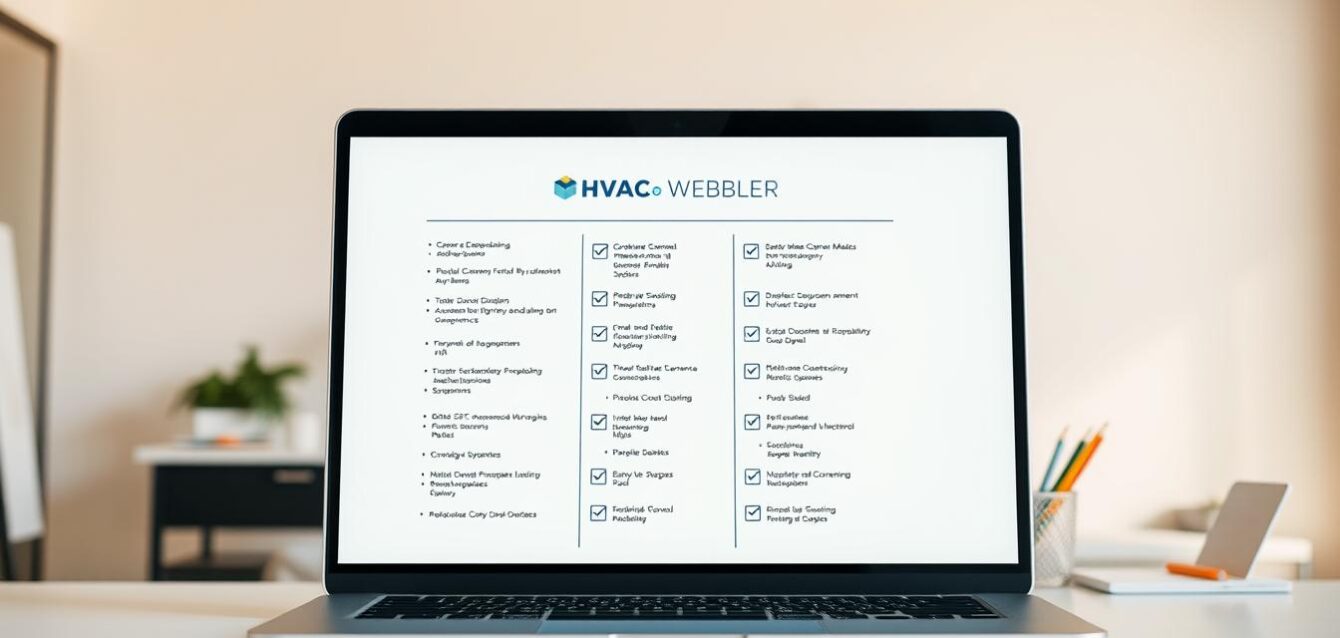Did you know 20% of heating and cooling businesses shut down every year? Yet, the industry is booming, projected to hit $296 million by 2028. If your company isn’t ranking online, you’re missing out—97% of homeowners search for local services on the web.
Most searches never scroll past Google’s first page. That’s why Macro Webber designed a 13-step strategy blending technical tweaks and local tactics. Mobile optimization matters too—60% of searches happen on phones.
ServiceTitan’s integration with Google Local Services Ads boosts lead conversions. Pair it with HawkSEM’s ConversionIQ to track returns. Ready to dominate search results? Let’s dive in.
Key Takeaways
- 20% of HVAC businesses close annually despite industry growth.
- 97% of customers find providers through online searches.
- 75% of clicks go to first-page Google results.
- Mobile optimization captures 60% of search traffic.
- Track ROI with tools like ConversionIQ.
Why HVAC SEO Matters for Your Business
Local search is the backbone of modern service-based businesses. When homeowners need repairs, 97% start their hunt online. If your company isn’t visible, you’re handing leads to competitors.
The Power of Local Search for HVAC Companies
Google’s Local Pack dominates searches like “HVAC repair near me.” Consistent NAP (Name, Address, Phone) details boost rankings by 37%. Choate’s AC, with 1,800+ reviews, saw 45% more clicks.
Carrier’s organic traffic grew 53% after refining local SEO strategies. Mobile optimization matters too—sites load fast convert 3.5x more often.
How SEO Drives Calls and Conversions
ServiceTitan users gain 53% more bookings when pairing search engine tactics with Schedule Engine. Marketers confirm SEO’s effectiveness—46% call it their top lead generator.
New businesses face a 70% failure rate. Those using local SEO survive 22% longer. Reviews, speed, and accurate listings turn searches into customers.
Optimize Your Google Business Profile
58% of service businesses see better map rankings after refining their profiles. A complete google business profile acts as a 24/7 storefront, turning searches into customers.
Essential Details to Include
Missing information hurts visibility. Ensure these are accurate:
- NAP: Local phone number, exact address, and service areas (use polygons, not cities).
- Hours: Update for holidays or emergencies.
- Services: List all 25+ categories, like “furnace repair” or “duct cleaning.”
One company boosted ratings from 3.2 to 4.7 by responding to reviews within 24 hours. Consistency matters—Google penalizes keyword-stuffed names like “Best HVAC Repair LLC.”
Maximize Posts and Updates
Posts with offers get 3x more clicks. Try this weekly strategy:
- Monday: Share seasonal tips (e.g., “Prevent Frozen Pipes”).
- Thursday: Highlight emergency services.
- Weekend: Promote discounts (e.g., “$50 Off Tune-Ups”).
Adding videos increased profile views by 214% for a Florida-based company. Use Macro Webber’s template for service descriptions, and include Schema markup for faster indexing.
Conduct Thorough Keyword Research
Targeting precise search terms drives 2.8x more conversions than generic phrases. Long-tail keywords like “24/7 furnace repair in [city]” outperform broad terms because they match user intent. Tools like Semrush and AnswerThePublic reveal what potential customers actually type.
Tools for Finding High-Impact Keywords
Semrush identifies gaps in your strategy, like seasonal spikes for “HVAC rebates.” Meanwhile, AnswerThePublic uncovers questions like “Why is my AC leaking?”—perfect for blog topics. Compare their strengths:
| Tool | Best For | Example Output |
|---|---|---|
| Semrush | Volume & competition data | “Emergency AC repair” = 1,200 searches/month |
| AnswerThePublic | Question-based queries | “How to fix a noisy furnace?” |
Balancing Short-Tail and Long-Tail Keywords
Use a 70/30 mix:
- 70% long-tail: Low competition, high intent (e.g., “duct cleaning for allergies”).
- 30% short-tail: Broad terms like “AC repair” to capture brand-aware users.
Avoid stuffing “HVAC services near me.” Google penalizes over-optimization. Instead, mine PAA boxes (People Also Ask) for subtopics to dominate.
One company achieved 3,830% traffic growth by targeting underserved keywords like “historic home HVAC upgrades.”
Track performance with Macro Webber’s spreadsheet template. Update quarterly—search trends shift with weather and rebate cycles.
Create High-Quality, Relevant Content
Engaging articles can boost your visibility and credibility. Fresh content improves rankings by 33% and keeps your audience engaged. Focus on topics that address customer pain points and seasonal needs.

Blog Topics That Attract Leads
Educational posts establish trust. Try these high-impact ideas:
- Seasonal guides: “Spring Maintenance Checklist” or “Winter Furnace Safety Tips.”
- Problem-solving: “Why Is My AC Blowing Warm Air?”
- Lead magnets: Offer a free Ultimate Furnace Maintenance Checklist in exchange for emails.
Seasonal Content Strategies
Align posts with weather trends. For example:
- Q1: Tax credit guides and post-winter repair tips.
- Q3: Energy-saving tips during peak summer.
One company saw a 214% lead increase with a well-timed HVAC Tax Credit Guide.
Repurpose top blogs into YouTube tutorials, like filter replacements. Video pages retain visitors 3x longer. Use tools like SurferSEO to optimize each piece for search intent.
Improve Your Website’s Page Speed
Every second counts when visitors decide to stay or leave your site. A 4-second delay causes 25% to abandon it. Faster loading pages rank higher and keep users engaged.
Test Your Current Performance
Use these tools to diagnose issues:
| Tool | Best For | Key Metric |
|---|---|---|
| GTmetrix | Detailed waterfall charts | Time to First Byte (TTFB) |
| PageSpeed Insights | Mobile-specific fixes | Core Web Vitals |
Quick Fixes for Faster Loading
Compress images: Use ShortPixel to reduce file sizes without losing quality. Large images slow down your site.
Upgrade hosting: Switching to WP Engine cut load times by 68% for one business. A CDN (Content Delivery Network) helps globally.
Lazy loading delays off-screen images until needed. Pair it with critical CSS to prioritize visible content.
“HTTP/3 adoption shaved 0.8 seconds off our load time—crucial for emergency service pages.”
Cache plugins like WP Rocket automate optimizations. Configure them to refresh only when content changes.
Ensure Mobile-Friendly Design
Mobile users now dominate online searches—ignoring them means losing potential customers. Since 2019, Google’s mobile-first indexing prioritizes how your site performs on phones. If it’s slow or hard to navigate, 53% of visitors will leave immediately.
Why Mobile Optimization Is Non-Negotiable
60% of searches happen on phones. A seamless experience keeps users engaged:
- Navigation menus: Use collapsible tabs for service pages.
- Font size: 16px minimum for readability on small screens.
- Touch targets: Buttons need 48x48px spacing to avoid misclicks.
One company saw a 57% boost in form completions after simplifying their mobile layout.
Testing Your Site’s Mobile Performance
Run these free tools to identify issues:
- Google’s Mobile-Friendly Test: Checks loading speed and responsiveness.
- Lighthouse: Scores your site on accessibility and SEO.
“Switching to AMP (Accelerated Mobile Pages) cut our bounce rate by 34%.”
For emergency service pages, consider Progressive Web Apps—they load instantly, even offline.
Build Local Citations and Listings
82% of customers verify profiles before hiring a service company. Consistent local SEO efforts ensure your business appears trustworthy and reliable. Listings on reputable directories act as digital references, boosting rankings by 47%.
Top Directories for Service Businesses
Focus on platforms where customers actively search:
- BBB: 82% of users check ratings here.
- Angi: Ideal for home services leads.
- HVAC-Talk: Industry-specific visibility.
| Directory | Best For | Audience Reach |
|---|---|---|
| BBB | Trust signals | National |
| Contractor Alliance | B2B referrals | Trade professionals |
Maintaining Consistent NAP Information
Incorrect Name, Address, or Phone (NAP) details confuse search engines. Use tools like Yext to sync data across 50+ platforms. A Texas-based company fixed 47 inconsistent listings and saw a 33% ranking boost.
“Schema markup helped our franchise locations rank 22% faster for geo-specific searches.”
Audit your citations quarterly with BrightLocal. Add local schema markup to highlight service areas and operating hours. Respond to directory reviews within 48 hours to build credibility.
Encourage and Manage Customer Reviews
Businesses with 4.7+ stars receive 112% more clicks than competitors. Reviews build trust and drive decisions—93% of consumers check them before hiring a service provider. A single negative rating can cost your company up to 30 customers.

Simple Ways to Boost Google Reviews
Ask at the right moment. Send an SMS template post-service: “Thanks for trusting us! Could you share your experience?” Include a direct link. ServiceTitan’s Reputation Management automates this.
Train technicians to mention reviews politely. Place QR code stickers on vans for easy scanning. Compare methods:
| Method | Response Rate | Best For |
|---|---|---|
| SMS Requests | 42% | Quick turnaround |
| Email Campaigns | 28% | Detailed feedback |
Responding to Feedback Effectively
Positive reviews: Thank them personally. Example: “We’re thrilled you enjoyed our prompt service!” Feature these in “Why Choose Us” schema markup.
Negative reviews: Reply within 24 hours. Offer solutions publicly, then take it offline. One business turned a 1-star review into a 5-star update by fixing the issue fast.
“Monthly review audits help us spot trends—like seasonal service gaps.”
Develop a Backlink Strategy
Quality backlinks are like digital referrals—they signal trust to search engines. A strong strategy can elevate your website above competitors. Focus on authoritative sources rather than quantity.
Where to Get Quality Backlinks
Prioritize links from respected platforms. Here’s where to start:
- Industry blogs: Guest posts on sites like Energy.gov or HVAC instructor blogs add credibility.
- Local partnerships: Sponsoring community events (e.g., little league teams) often earns .org links.
- Broken link building: Use Ahrefs to find dead links on relevant sites, then suggest your content as a replacement.
| Source | Domain Authority Boost | Example |
|---|---|---|
| .edu sites | Up to 22% | University energy efficiency studies |
| Trade associations | 15-18% | ASHRAE member directories |
How to Avoid Spammy Link-Building Tactics
Google penalizes shady practices. Steer clear of:
- Link exchanges: Reciprocal links trigger algorithm flags.
- Low-quality directories: Stick to reputable platforms like BBB.
- Keyword-stuffed anchor text: Keep it natural—use brand names or phrases like “learn more.”
“Skyscraper techniques—upgrading existing top-ranking content—increased our backlink profile by 40% in six months.”
Use Google’s Disavow Tool for toxic links. Regularly audit your profile with Moz or SEMrush. Co-marketing with complementary brands (e.g., air filter manufacturers) can yield high-value links through joint webinars.
Leverage Social Media for SEO
Social platforms drive 40% of service business leads—are you maximizing their potential? Videos and posts amplify visibility, turning followers into customers. A strategic approach blends platform strengths with your site’s SEO goals.
Top Platforms to Prioritize
Not all networks suit service businesses. Focus on these high-converting options:
| Platform | Best Use | Engagement Tip |
|---|---|---|
| Local ads & reviews | Embed Google Reviews in posts | |
| TikTok | Quick fixes (e.g., filter changes) | Use trending sounds for reach |
| B2B partnerships | Techs share behind-the-scenes |
Pinterest infographics simplify complex topics like thermostat settings. Instagram Stories highlight emergency services with swipe-up links. Track performance with UTM codes.
Seamless Website Integration
Sync social efforts with your marketing funnel:
- Embed feeds: Show recent posts on service pages.
- Cross-promote: Blog snippets link to full content on LinkedIn.
- Social listening: Monitor “AC broken” tweets for real-time leads.
“Employee advocacy programs increased our referral traffic by 57%—techs became trusted voices.”
Facebook Local Service Ads convert at 9.8%. Pair them with lead forms to capture inquiries directly. Always link back to optimized landing pages.
Track and Analyze Your SEO Performance
Data-driven decisions separate thriving businesses from those stuck guessing. Without measuring results, you can’t refine your approach or spot hidden opportunities. Tools like ConversionIQ reveal which efforts drive real returns.
Essential Metrics for Continuous Improvement
Focus on these critical indicators to gauge success:
- Click-through rates (CTR): Compare impressions to clicks in Google Search Console. Aim for 3-5% on high-priority terms.
- Keyword rankings: Track positions weekly for core terms. Use SEMrush to identify cannibalization—when multiple pages compete for the same query.
- Core Web Vitals: Monitor loading speed, interactivity, and visual stability. Pages scoring “Good” retain 38% more visitors.
Analyze conversion paths for service pages. Tools like Hotjar show where users drop off before booking. One company reduced bounce rates by 27% after simplifying their contact form.
Powerful Tools for Actionable Insights
Combine these platforms for a complete picture:
| Tool | Primary Use | Key Feature |
|---|---|---|
| Google Analytics 4 | Traffic sources | Event-based tracking |
| Ahrefs | Backlink analysis | Competitor gap reports |
| Screaming Frog | Technical audits | Broken link detection |
Set up custom dashboards to view data at a glance. For example, track monthly organic growth against local ad spend. ConversionIQ excels at tying efforts to revenue—showing exactly which keywords drive calls.
“Weekly rank tracking helped us pivot quickly—we shifted focus to ‘boiler repair’ before winter demand peaked.”
Run competitor gap analyses quarterly. Identify terms they rank for but you don’t. Prioritize those with high commercial intent, like “emergency furnace repair cost.”
Conclusion: Implementing Your HVAC SEO Checklist
Now that you’ve explored these actionable steps, it’s time to put them into practice. Macro Webber’s 90-day timeline simplifies execution—from optimizing services to engaging customers with reviews and local content.
One client saw 214 leads monthly after refining their strategy. Ready for similar results? Claim your free Google Business Profile audit at hello@macrowebber.com or schedule a consultation today.
Download our branded checklist to track progress. For urgent fixes, call 353-405-7665. Let’s grow your business—because at Macro Webber, we’re cultivating solutions to transform business.



